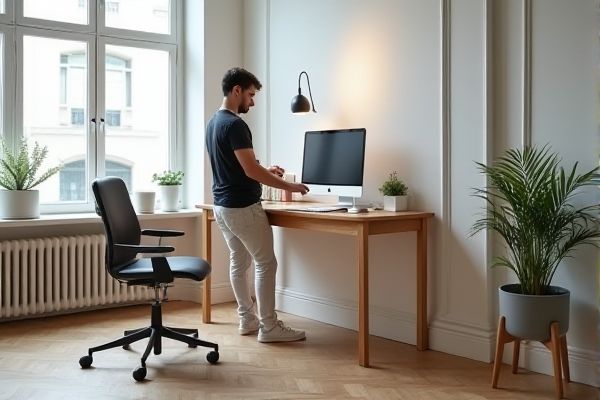
Standard desk height typically measures around 29 to 30 inches, offering a fixed surface suited for general use, whereas adjustable desk height allows customization to fit your ergonomic needs, improving posture and comfort throughout the day. Explore the article to determine which desk type best supports your workflow and health.
Table of Comparison
| Feature | Standard Desk Height | Adjustable Desk Height |
|---|---|---|
| Height Range | Fixed, typically 28-30 inches (71-76 cm) | Variable, usually 22-48 inches (56-122 cm) |
| Ergonomics | Limited customization, may cause strain | Customizable for sitting or standing, reduces strain |
| User Comfort | One-size-fits-all, may not suit all heights | Adjusts to individual user preference |
| Health Benefits | Increased risk of poor posture | Encourages movement, reduces sedentary behavior |
| Cost | Generally lower cost | Higher initial investment |
| Durability | Simple design, fewer moving parts | More complex, may require maintenance |
| Use Case | Best for fixed seating workstations | Ideal for flexible sit-stand work environments |
Understanding Standard Desk Height
Standard desk height typically ranges from 28 to 30 inches, designed to accommodate the average adult sitting posture for ergonomic comfort. Adjustable desks offer customizable height settings from about 22 to 50 inches, promoting better ergonomic alignment by allowing users to switch between sitting and standing positions. Understanding the differences helps optimize workspace ergonomics, reducing strain and improving posture during extended work periods.
What Is an Adjustable Desk?
An adjustable desk allows you to modify the height to suit your comfort and ergonomics, unlike a standard desk with a fixed height typically around 29 to 30 inches. This customization helps reduce strain on your neck, back, and wrists by enabling you to alternate between sitting and standing positions throughout the day. Investing in an adjustable desk supports better posture and can enhance productivity by adapting to your specific workspace needs.
Ergonomics of Standard Desk Height
Standard desk height, typically ranging from 28 to 30 inches, suits average adult proportions but may not accommodate all body types, potentially leading to discomfort or poor posture. Ergonomically, fixed-height desks often fail to support optimal wrist and arm positioning, increasing the risk of strain or repetitive stress injuries. Your workspace benefits from adjustable desks, which allow customization to your body's needs, promoting better alignment and reducing the risk of musculoskeletal issues.
Benefits of Adjustable Desk Height
Adjustable desk height offers significant ergonomic advantages by allowing you to alternate between sitting and standing positions, reducing strain on your back and neck. This flexibility promotes better posture, increases energy levels, and can enhance productivity throughout the workday. Compared to standard desk heights, adjustable desks accommodate various body types and preferences, supporting a healthier and more comfortable workspace.
Choosing the Right Desk for Your Workspace
Standard desk height typically ranges from 28 to 30 inches, suitable for most adults working in a seated position, ensuring ergonomic comfort and proper posture. Adjustable desk height options offer flexibility, allowing users to switch between sitting and standing positions, which can improve circulation and reduce the risk of musculoskeletal issues. Selecting the right desk involves considering individual height, work habits, and ergonomic needs to enhance productivity and maintain long-term health.
Health Implications: Standard vs Adjustable Desks
Standard desk height, typically around 29 to 30 inches, may contribute to poor posture and increased risk of musculoskeletal issues if it does not suit your body dimensions. Adjustable desks allow for personalized height settings, promoting ergonomic alignment and reducing strain on the back, neck, and wrists. By using an adjustable desk, you can alternate between sitting and standing positions, which has been shown to improve circulation and reduce the risk of sedentary-related health problems.
Productivity Impact: Does Desk Height Matter?
Standard desk height, typically around 29-30 inches, may not accommodate individual ergonomic needs, potentially leading to discomfort and reduced productivity over time. Adjustable desks allow customization of height to suit sitting or standing positions, promoting better posture, reducing fatigue, and enhancing focus and efficiency. Studies show that ergonomic adjustments, including desk height flexibility, can improve work performance and decrease musculoskeletal strain.
Cost Comparison: Standard vs Adjustable Desks
Standard desk heights typically range from 28 to 30 inches and come at a lower initial cost, averaging between $100 and $300. Adjustable desks, offering height variability from about 22 to 48 inches, generally have higher price points, often starting around $300 and reaching up to $1,000 or more depending on features. While the upfront investment for adjustable desks is higher, their ergonomic benefits and flexibility can lead to improved productivity and reduced health-related expenses over time.
Space & Design Considerations
Standard desk height typically ranges from 28 to 30 inches, offering a consistent workspace that fits most conventional office setups but may limit ergonomic customization. Adjustable desk height models provide flexibility from about 22 to 48 inches, enabling you to switch between sitting and standing positions, optimizing comfort and productivity in various environments. This adaptability supports better space utilization and design integration, accommodating diverse user needs and multifunctional areas.
Which Desk Height Is Best for You?
Standard desk height typically ranges from 28 to 30 inches, suitable for individuals of average height and fixed seating positions. Adjustable desks offer customizable height settings, allowing you to alternate between sitting and standing, which promotes better posture and reduces strain. Your choice depends on your ergonomic needs, workspace flexibility, and preference for movement throughout the day.
 homyna.com
homyna.com